- GCN/BACODINE POSITION NOTICE
TITLE: GCN/IPN POSITION NOTICE
NOTICE_DATE: Fri 05 Apr 02 18:16:23 UT
NOTICE_TYPE: IPN Single Box
IPN_NUMBER: 255
GRB_DATE: 12369 TJD; 95 DOY; 02/04/05
GRB_TIME: 2486.00 SOD {00:41:26.00} UT
GRB_IPN_RA: 209.5425d {+13h 58m 10s} (J2000),
209.5752d {+13h 58m 18s} (current),
208.8196d {+13h 55m 17s} (1950)
GRB_IPN_DEC: -31.3877d {-31d 23' 15"} (J2000),
-31.3986d {-31d 23' 54"} (current),
-31.1446d {-31d 08' 40"} (1950)
GRB_ERROR1_RA1: 209.2163d {+13h 56m 52s} (J2000)
GRB_ERROR1_DEC1: -31.3934d {-31d 23' 35"} (J2000)
GRB_ERROR1_RA2: 209.5944d {+13h 58m 23s} (J2000)
GRB_ERROR1_DEC2: -31.3500d {-31d 21' 00"} (J2000)
GRB_ERROR1_RA3: 209.4908d {+13h 57m 58s} (J2000)
GRB_ERROR1_DEC3: -31.4253d {-31d 25' 30"} (J2000)
GRB_ERROR1_RA4: 209.8730d {+13h 59m 30s} (J2000)
GRB_ERROR1_DEC4: -31.3813d {-31d 22' 52"} (J2000)
GRB_ERROR: 16.82 [arcmin radius of circumscribing circle, 3 sigma]
GRB_BOX_AREA: 74 [sq.arcmin]
GRB_PEAK_FLUX: 1.0e-06 [erg/cm2/sec in 25-100 keV]
GRB_FLUENCE: 3.0e-05 [erg/cm2 in 25-100 keV]
GRB_DURATION: 40.0 [sec]
SUN_POSTN: 13.88d {+00h 55m 31s} +5.94d {+05d 56' 09"}
SUN_DIST: 150.60 [deg]
MOON_POSTN: 291.46d {+19h 25m 50s} -24.43d {-24d 25' 33"}
MOON_DIST: 71.02 [deg]
COMMENTS: IPN triangulation localization.
COMMENTS: This is a preliminary, 3 sigma error box.
COMMENTS: GCN message is being issued.
- GCN notice #1325
K. Hurley and T. Cline, on behalf of the Ulysses GRB team, F. Frontera,
C. Guidorzi, and E. Montanari, on behalf of the BeppoSAX GRBM team, I.
Mitrofanov, D. Anfimov and M. Litvak on behalf on HEND/Odyssey GRB
team, and W. Boynton, C. Fellows, K. Harshman, and C. Shinohara, on
behalf of the GRS/Odyssey GRB team, report:
Ulysses, Mars Odyssey - HEND, and BeppoSAX observed this GRB at 02486 s.
As observed by Ulysses, it had a duration of ~40 seconds, a
25-100 keV fluence of ~3x10^-5 erg/cm2, and a peak flux of
~10^-6 erg/cm2 s over 0.5 s.
We have triangulated it to a preliminary, 3 sigma error box
with approximate area 75 square arcminutes whose coordinates
are:
ERROR BOX CENTER: 209.543 -31.388
ERROR BOX CORNER: 209.216 -31.393
ERROR BOX CORNER: 209.594 -31.350
ERROR BOX CORNER: 209.491 -31.425
ERROR BOX CORNER: 209.873 -31.381
This error box can be improved.
With this burst, we announce the resumption of IPN activities
with the Mars Odyssey spacecraft. We had intended to announce
this with a GCN message prior to the localization of our first
burst; that announcement will now be sent sometime next week.
- red DSS finding chart
ps-file
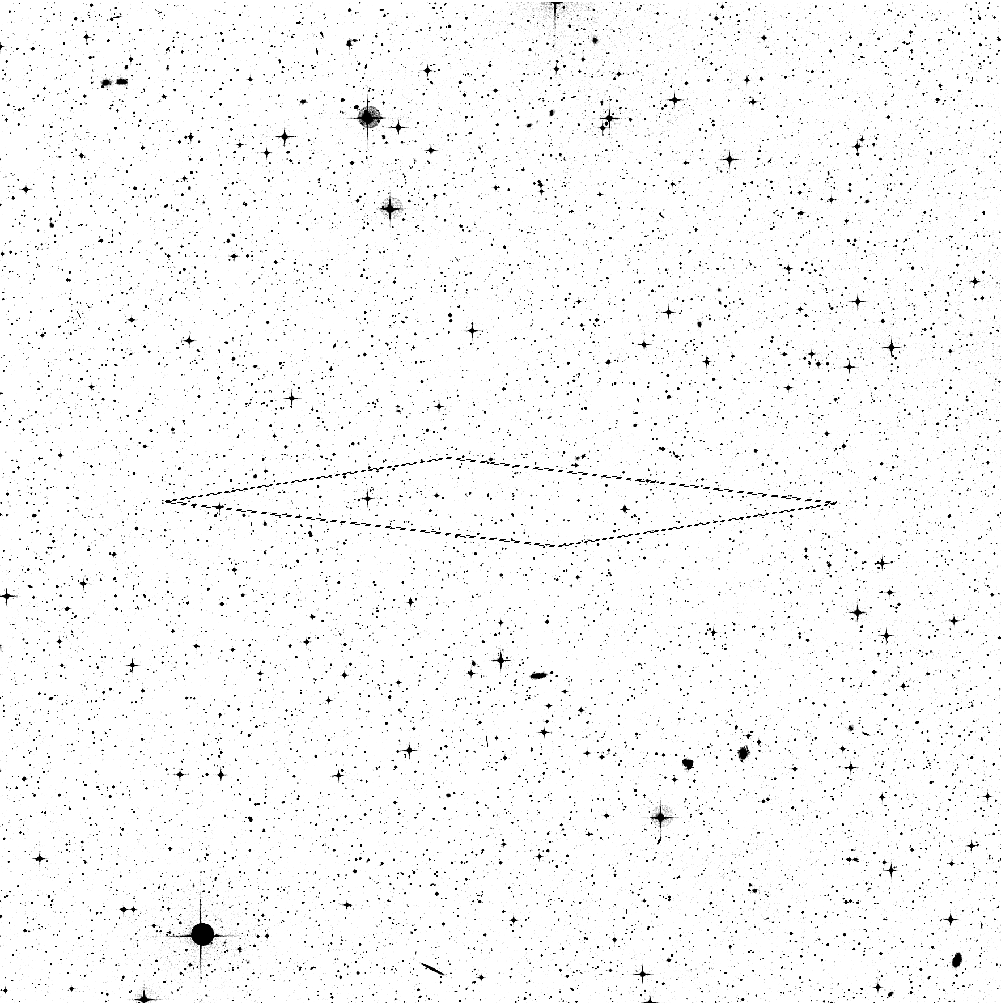
- GCN notice #1326
P.A. Price, B.P. Schmidt (RSAA, ANU) and T.S. Axelrod (Arizona)
report:
We have observed the error box of GRB 020405 with the robotic MSO 50-inch
telescope + MACHO imager at 2002 Apr 05.75 UT (approximately 17.5 hours
after the GRB). Upon visual inspection of the images, we find a source
that is not present on the second Digitised Sky Survey. The source is
R ~ 18.5 mag and is located at coordinates:
RA: 13:58:03.12 Dec: -31:22:22.2 J2000
with error approximately 0.3 arcsec in each coordinate.
A finding chart is available from:
http://darkalf.caltech.edu/~pap/grb020405finder.ps
This message may be cited.
- GCN notice #1327
GRB 020405, U-band observations
A. J. Castro-Tirado, J. Gorosabel (Instituto de Astrofísica de
Andalucia, IAA-CSIC, Granada), T. Augusteijn (Isaac Newton
Group of Telescopes) and José María Castro Cerón (IAA-CSIC
and ROA, San Fernando) report:
We have observed the central region of the GRB 020405 error box
(Hurley et al., GCN Circ. 1325) with the Prime Focus Camera at the
4.2-m William HerschelTelescope at the ORM in La Palma, providing
a 16'.2 square field of view. A comparison of the U- and R-band
images obtained on Apr 6.104-6.122 UT reveals an extremely blue
object at the position of the optical candidate proposed by Price et al.
(GCN Circ. 1326) thus supporting the relationship with the GRB.
This U-band detection would imply that the redshift is < 2.1 .
This message can be cited.
- GCN notice #1328
E. Palazzi, N. Masetti (IASF-CNR, Bologna), E. Pian (INAF, OA Trieste), J.
Licandro (TNG), R. Maiolino (INAF, OA Arcetri), P. Saracco (INAF, OA
Brera), F. Fiore (INAF, OA Roma), on behalf of a large collaboration,
report:
"We have observed the central portion of the error box of GRB020405 (GCN
1325) at TNG with Dolores and V filter for 10 minutes, starting 2002 April
6, 01:34 UT. The seeing was 1.6". From a preliminary analysis of the
images we detect the source reported by Price et al. (GCN 1326) with a
magnitude V = 20.2 +- 0.3, assuming V=18.5 and V=17.6 for the comparison
USNO-A2.0 stars 0525-16813005 and 0525-16815468, respectively.
This message may be cited."
- GCN notice #1329
Fading Optical Afterglow and Possible Host Galaxy of GRB 020405
J. Hjorth (U. Copenhagen), J. Fynbo (ESO), E. Pian (INAF, OA Trieste),
A. Delsanti (ESO), B. L. Jensen (U. Copenhagen), J. Gorosabel (IAA, Granada),
H. Pedersen (U. Copenhagen), and M. I. Andersen (U. Oulu) report:
Optical images of the candidate afterglow (Price et al., GCN #1326) of
GRB 020405 (Hurley et al., GCN #1325) were obtained at the Danish 1.5-m
telescope on La Silla as follows:
Date Filter Exp. time
6 April 2002 UT (sec)
03:16 R 600
05:04 R 600
05:16 V 600
05:37 B 1200
05:56 Gunn i 900
Calibrating our photometry to the reference star USNO525_16813005 (for
which we assume B = 19.3 and R = 17.8) we find R = 20.9 and B - R = 0.0.
In addition, comparison between the two R-band images indicates that the
afterglow faded with 0.099 +- 0.040 mag between the two epochs, thus
supporting the interpretation that the source is indeed the afterglow of
GRB 020405.
A color image (based on the BVi images) posted at
http://www.astro.ku.dk/~jens/grb020405_color.gif
shows the very blue color of the afterglow (see also Castro-Tirado et al.,
GCN #1327).
In addition, the R-band images posted at
http://www.astro.ku.dk/~jens/grb020405_host1.gif and
http://www.astro.ku.dk/~jens/grb020405_host2.gif
reveal a bright galaxy located ~ 2" to the south-west of the afterglow.
If this is the host galaxy, then the redshift of GRB 020405 may be fairly
low, making it a good candidate for a search of an underlying supernova.
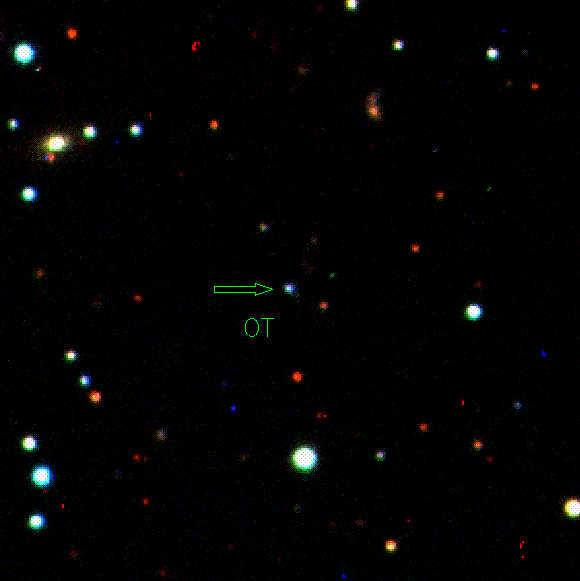
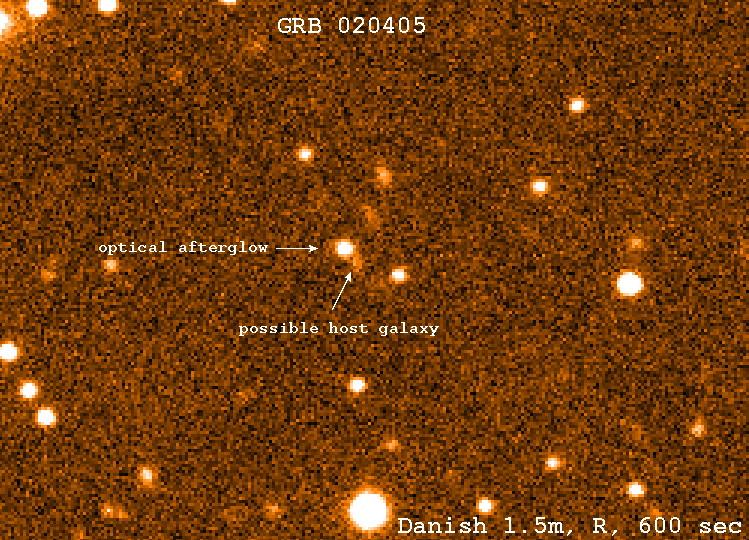
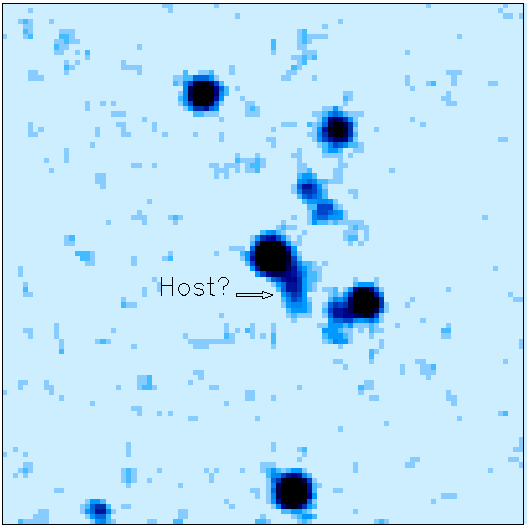
- GCN notice #1330
N. Masetti, E. Palazzi (IASF-CNR, Bologna), E. Pian (INAF, OA Trieste), J.
Hjorth (U. Copenhagen), A. Castro-Tirado (IAA-CSIC, Granada), H.
Boehnhardt (ESO), P. Price (RSAA, ANU), on behalf of the GRACE
collaboration, report:
"On 2002 April 6.213 UT we have taken a 30 min spectrum of the candidate
afterglow of GRB020405 (GCN 1326) with the VLT equipped with FORS1 and low
resolution grating 150I+OG590. After a preliminary analysis of the
spectrum, narrow emission lines, likely from the host galaxy, are seen
which may be identified with [O II], [O III] and Hbeta at a redshift of
0.695 +- 0.005. At the same redshift we also detect the Ca II doublet in
absorption.
This message may be cited."
- GCN notice #1331
E. Berger, S. R. Kulkarni (Caltech), and D. A. Frail (NRAO) report on
behalf of the Caltech-NRAO-CARA GRB collaboration:
"On 2002, April 6.22 UT we observed a field centered on the position of
the optical afterglow candidate reported by Price et al. (GCN #1326) with
the VLA at 8.46 GHz. We detect a 490 microJy radio source coincident with
the position of the optical source at (J2000):
RA=13 58 03.125, DEC=-31 22 21.90
with an uncertainty of 0.03 arcsec in both coordinates.
Further observations with the VLA are in progress, and we strongly urge
millimeter and submillimeter observations to determine the density and
profile of the circumburst environment."
This message may be cited.
- GCN notice #1333
P.A. Price, B.P. Schmidt (RSAA, ANU) and T.S. Axelrod (Arizona)
report:
We have re-observed the afterglow candidate (GCN #1326) with the
robotic MSO 50-inch telescope + MACHO imager at 2002 Apr 6.43.
The afterglow candidate has faded by approximately 1 magnitude
since the observations of Apr 5.75 (GCN #1326), from which we
derive an optical decay index of alpha ~ 1.26. Using the reference
star of Hjorth et al. (GCN #1329), we find that R ~ 19.9 mag at
Apr 6.43. This value does not appear to be consistent with that of
Hjorth et al., which might be explained by the filter mis-match
and use of different apertures.
This message may be cited.
- GCN notice #1335
A. Gal-Yam, E. O. Ofek and Y. Lipkin (Wise Observatory, TAU) report:
We have observed the center of the error box of GRB 020405 using
the Wise Observatory 1m telescope + Tek CCD camera at 2002 Apr 05.95 UT.
Three 900 s R-band images were obtained. We identify the candidate OT
proposed by Price et al. (GCN 1326) for which we measure an R-band
magnitude of 18.8 +/- 0.14 mag, using the R=17.8 mag reference star from
Hjorth et al. (GCN 1329). Our measured value seems to agree better
with those of Price et al. (GCN 1333) than those of Hjorth et al.
(GCN 1329).
- GCN notice #1336
Revised Photometry of the Optical Afterglow of GRB 020405
J. Hjorth (U. Copenhagen) reports:
The calibration of the PSF photometry reported in GCN #1329 relied on a
misidentification of the USNO A2.0 star 0525_16813005 with 0525_16812476.
Calibration to 0525_16813005 yields R = 19.8 and B - R = 1.0 at April 6.21 UT,
consistent with the reports of Palazzi et al. (GCN #1328), Price et al.
(GCN #1333), and Gal-Yam et al. (GCN #1335). The systematic error in these
values is of the order of +- 0.3 mag. I apologize for the impact this error
may have had on follow-up strategies and thank Javier Gorosabel and Paul Price
for pointing out the problem.
Additional data taken with the DK1.5m between Apr 7.13 and Apr 7.37 confirm
the continued fading of the source. A careful analysis of these data is in
progress!
- GCN notice #1337
S. Covino, G. Ghisellini, P. Saracco, G. Tagliaferri, F. Zerbi
(Observ. of Brera, Milan, Italy); S. Di Serego, A. Cimatti, Della Valle
(Observ. of Arcetri, Florence, Italy); F. Fiore, G.L. Israel, L. Stella
(Observ. of Monte Porzio, Rome, Italy); M. Vietri (Univ. Rome 3, I);
N. Kawai (RICHEN, Japan); D. Lazzati (IoA, Cambridge, UK); S. Ortolani
(Univ. of Padua, Italy); L. Pasquini (ESO, Germany); G. Ricker (MIT,
USA); E. Le Floch, P. Goldoni, F. Mirabel (CEA, F), H. Boehnhardt (on
behalf of the Melipal team, ESO, Paranal, Chile) report:
On 2002 April 7.14 we observed the optical counterpart of GRB 020405
reported by Price et al. (GCN 1326). The observations were performed
with the ESO VLT-3 (Melipal) telescope equipped with FORS1 with a V
filter in the imaging polarimetry mode. The transient source is clearly
detected and the acquisition image allowed to derive the Bessel V
magnitude of the transient, V=21.45 +/- 0.1, assuming V=18.5 and V=17.6
for the comparison USNO-A2.0 stars 0525-16813005 and 0525-16815468,
respectively, as reported in Palazzi et al. (GCN 1328).
This message is citeable.
- GCN notice #1340
P.A. Price (Caltech), M. Pettini (Cambridge), N. Reddy, C. Steidel
and S.R. Kulkarni (Caltech) report on behalf of the REACT GRB
collaboration:
We have observed the afterglow of GRB 020405 (GCN #1326) with the
Keck II telescope + ESI. Observations consisted of 2x1800 sec exposures
in the eschellete mode. In this mode we are able to resolve the sky
lines, which is particularly important since at the reported redshift
of z = 0.695 (Masetti et al., GCN #1330) the [O II] line is coincident
with a strong atmospheric line. A preliminary reduction of the spectra
reveals emission lines of [O II], Hbeta, and [O III], at a mean redshift
of z = 0.6898 +/- 0.0005. In particular, we resolve the [O II] doublet
and thus we consider the redshift to be secure.
This message may be cited.
- GCN notice #1345
S. Covino, G. Ghisellini, P. Saracco, G. Tagliaferri, F. Zerbi
(Observ. of Brera, Milan, Italy); S. Di Serego, A. Cimatti, Della Valle
(Observ. of Arcetri, Florence, Italy); F. Fiore, G.L. Israel, L. Stella
(Observ. of Monte Porzio, Rome, Italy); M. Vietri (Univ. Rome 3, I);
N. Kawai (RICHEN, Japan); D. Lazzati (IoA, Cambridge, UK); S. Ortolani
(Univ. of Padua, Italy); L. Pasquini (ESO, Germany); G. Ricker (MIT,
USA); E. Le Floch, P. Goldoni, F. Mirabel (CEA, F), H. Boehnhardt (on
behalf of the Melipal team, ESO, Paranal, Chile) report:
On 2002 April 8.164 we observed the optical counterpart of GRB 020405
reported by Price et al. (GCN 1326). The observations were performed
with the ESO VLT-3 (Melipal) telescope equipped with FORS1 with a V
filter in the imaging polarimetry mode. The transient source is clearly
detected and the acquisition image allowed to derive the Bessel V
magnitude of the transient, V=22.0 +/- 0.1, assuming V=18.5 and V=17.6
for the comparison USNO-A2.0 stars 0525-16813005 and 0525-16815468,
respectively, as reported in Palazzi et al. (GCN 1328).
Relative photometry between our V band observations of April 7.143
and 8.164 shows that the OT decayed by 0.60 +- 0.05 magnitudes, implying
a decay slope of 1.52 +- 0.12, also consistent with
the previous V mesurement by Palazzi et al (GCN 1328).
This message is citeable.
- GCN notice #1369
D. Malesani, G. Ghisellini, S. Covino (Brera Observ., Milan) and
D. Lazzati (IoA Cambridge, UK) report:
According to the idea of Frail et al. (2001, ApJ, 562, L55) that the jet
energies of GRBs are universal, an achromatic jet break in the afterglow
lightcurve is predicted for all bursts at the time
t_jet = 20.4 (1+z) / (E_gamma/1e52) days,
where E_gamma is the observed (i.e. isotropic) energy of the prompt
emission. This result is independent of the unknown efficiency and
circumburst density.
For GRB 020405, with z=0.69 (GCN 1330 and GCN 1340) and E_gamma>4.3e52
erg (assuming H_0=65, Omega_m=0.3, Omega_Lambda=0.7 and taking the
fluence to be larger than the reported value in the 25-100 keV band:
3e-5 erg/cm2, GCN 1325), we have t_jet<8 days. Hence the break
should have occured before April 13.
Our V-band data (GCN 1337, 1345) connect very well with a previous
measurement by Palazzi et al. (GCN 1328), who use the same calibration
stars. The decay slope is hence very well defined (1.52+-0.04), making
easier the possible detection of the predicted break (see the lightcurve
at:
http://www.merate.mi.astro.it/~gabriele/020405.html).
Since both the detection or the non-detection of the break would be very
important to constrain Frail et al. idea, we urge photometric
observations of the afterglow of this burst.
This message can be cited.
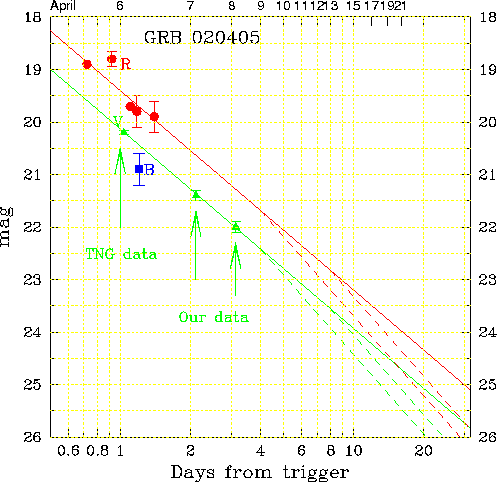
- GCN notice #1375
N. Masetti, E. Palazzi (IASF/CNR, Bologna), E. Maiorano, A. Simoncelli
(U. Bologna), E. Pian (INAF, OA Trieste), A. Castro-Tirado (IAA-CSIC,
Granada), A. Fruchter (STScI, Baltimore), J. Greiner (MPE Garching
and AI Potsdam), J. Hjorth (U. Copenhagen), L. Kaper, E. van den Heuvel
(U. Amsterdam), R. Cabanac, A. Kaufer (ESO), on behalf of the GRACE
Collaboration, report:
"We have obtained an R-band image (2 x 3 minutes integration) of GRB020405
from VLT-UT3 (Melipal) plus FORS1 on 2002 Apr. 15.244 under a seeing of
0.65 arcsec.
We find that the OT is located within a complex environment composed of
at least four extended objects, one of which is underlying the OT and
showing a bright knot (possibly a star-forming region, or alternatively
the host nucleus) ~1 arcsec south of the OT itself.
Also, the presumed host galaxy indicated by Hjorth et al. (GCN #1329)
and located ~2 arcsec southwest of the OT seems not to be the actual host
but a galaxy which is likely interacting with it.
Indeed, a spectrum of this galaxy taken with Melipal+FORS1 on
2002 April 7.310 shows that it is at the same redshift of the OT
(GCNs #1330, #1340).
This finding strengthens the suggestion that GRBs are sometimes associated
with interacting galaxies possibly displaying substantial star formation,
as seen e.g. for GRB001007 (Castro Ceron et al. 2002, A&A, in press
[astro-ph/0110049]).
No suggestion of a break in the light curve (see GCN #1369) is apparent
up to ~10 days after the GRB.
However, in the VLT image reported above, the OT brightness is already
substantially contamined by the host emission. For this reason it would
be quite difficult to see any future possible break in the OT light
curve with ground-based observations.
A close-up of the VLT R-band field around the OT can be found at:
http://tonno.tesre.bo.cnr.it/~masetti/grb020405.html
This message can be cited.".
- GCN notice #1388
A. Simoncelli, E. Maiorano (U. Bologna), E. Palazzi, N. Masetti
(IASF/CNR, Bologna), E. Pian (INAF, OA Trieste), J. Hjorth (U.
Copenhagen), A. Castro-Tirado (IAA-CSIC, Granada), A. Fruchter
(STScI, Baltimore), J. Greiner (MPE Garching and AI Potsdam), L.
Kaper, E. van den Heuvel (U. Amsterdam), A. Delsanti, M. Billeres
(ESO), on behalf of the GRACE Collaboration, report:
"We have acquired BVRcIc photometry of the field of GRB020405 with the
Danish 1.54m and NTT 3.58m ESO telescopes at La Silla, Chile.
We placed the photometric data of 6 selected stars, together with an
R-band image of the field on which the stars are marked, at the URL:
http://tonno.tesre.bo.cnr.it/~masetti/grb020405_phot.html
The current photometry has a potential external zero-point error of about
three percent that needs to be added in quadrature to the Poisson errors
given for the magnitude uncertainties of the selected stars.
Specifically, the magnitudes of the USNO-A2.0 stars 0525-16813005 and
0525-16815468 (Palazzi et al., GCN #1328; Hjorth et al., GCN # 1329),
which are labeled as stars # 2 and # 5 of our sample, are
V = 19.01 +- 0.01, R = 18.48 +- 0.01 for the first one and
V = 17.92 +- 0.01 for the second.".
This message can be cited.
- GCN notice #1431
S. Covino, G. Ghisellini, D. Malesani, P. Saracco, G. Tagliaferri, F.
Zerbi (Observ. of Brera, Milan, Italy); S. Di Serego, A. Cimatti, M. Della
Valle (Observ. of Arcetri, Florence, Italy); F. Fiore, G.L. Israel, L. Stella
(Observ. of Monte Porzio, Rome, Italy); M. Vietri (Univ. Rome 3, I); N.
Kawai (Tokyo Tech, Japan); D. Lazzati (IoA, Cambridge, UK); S. Ortolani (Univ.
of Padua, Italy); L. Pasquini (ESO, Germany); G. Ricker (MIT, USA); E. Le
Floch, P. Goldoni, F. Mirabel (CEA, F) report:
On 2002 April 7.21 and April 8.26 we observed the optical counterpart to
GRB020405. The observations were performed with the ESO VLT-3 (Melipal)
telescope equipped with FORS1 with a Bessel V band filter in the imaging
polarimetry mode. The transient source is clearly detected superposed to
a bright galaxy. The acquisition images allowed us to derive the magnitude
of the transient as reported in GCN 1337 and GCN 1345 (Covino et al.).
On April 7.21 (2.1 days after the GRB) we found linear polarization at
the level of 1.93 +/- 0.33 per cent with position angle 154 +/- 5 degrees
while on April 8.26 (3.2 days after the GRB) we found linear polarization at
the level of 1.23 +/- 0.43 per cent with position angle 168 +/- 9 degrees.
Polarization measurements were corrected for any instrumental effect or
measurement bias and the reported polarization degrees and position
angles are derived from Stokes parameters normalized to the average of the
field stars.
This message is citeable.
- GCN notice #1458
P.A. Price (RSAA, ANU), S.R. Kulkarni, D.W. Fox and J.S. Bloom
(Caltech) report on behalf of the larger Caltech-NRAO-CARA GRB
collaboration:
We observed the afterglow of GRB 020405 (GCN #1326) with HST+WFPC2 at
several epochs spanning 19-31 days after the GRB in F555W, F702W and
F814W, with additional observations approximately two months after the
GRB to remove host contamination. These observations formed part of
our large Cycle 10 program to search for SNe underlying low redshift
GRBs.
We have performed Novicki-Tonry photometry (see astro-ph/0207187) on
both ground-based and HST imaging. The resultant light curve,
including data from Bersier et al. (astro-ph/0206465), is at
http://www.mso.anu.edu.au/~pap/grb020405/.
An excess of flux is evident in the HST images, compared to an
extrapolation of the light-curve from early times. Based on the red
colour and the time of peak emission, we identify this excess as a SN
associated with GRB 020405. We have plotted the light-curve of SN
1998bw at z=0.695 (Masetti et al., GCN #1330) and dimmed by 0.5 mag as
a comparison. This SN appears to be red relative to SN 1998bw, but
this is sensitive to the amount of flux in the afterglow at the final
available HST images. Further HST observations to measure the host
galaxy and remove this ambiguity are planned for August.
This message may be cited.
- Light (and description) curve from
http://www.mso.anu.edu.au/~pap/grb020405/
Below is the host-subtracted light-curve of GRB 020405 from HST observations.
Fluxes are relative to the flux of the afterglow in the final available HST
images in each filter (since image subtraction has been used).
Filled points are measurements made from HST. Open points are ground-based
measurements. The majority of R-band points in this plot have been taken from
Bersier et al.,
astro-ph/0206465. B- and I- band points are mainly from observations with
the 40-inch telescope at Siding Spring Observatory.
The model has been corrected for Galactic extinction, but not extinction
within the host galaxy. A SN similar to SN 1988bw at z=0.695 (Masetti et al., GCN #1330)
has been included for comparison. It appears that the bump is red relative to
SN 1998bw, but this is sensitive to the flux of the afterglow in the final
available HST images. We expect to observe the host galaxy in August 2002 to
remove this ambiguity.
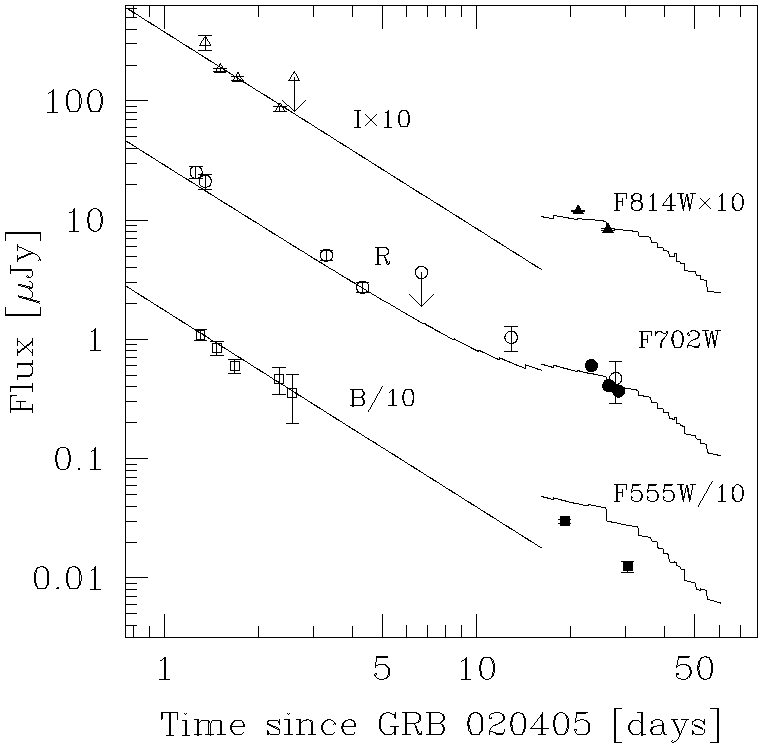
- 1301.0646 from 7 Jan 13
Sharon Rapoport et al.: On the significance of the excess number of strong MgII absorbers observed towards Gamma-ray bursts
The number of strong (equivalent width > 1A) MgII absorbers observed towards Gamma-ray bursts (GRBs) has been found to be statistically larger
than the number of strong absorbers towards quasi-stellar objects (QSOs). We formalize this "MgII problem" and present a detailed explanation
of the statistical tools required to assess the significance of the discrepancy. We find the problem exists at the 4{\sigma} level for GRBs
with high-resolution spectra. It has been suggested that the discrepancy can be resolved by the combination of a dust obscuration bias towards
QSOs, and a strong gravitational lensing bias towards GRBs. We investigate one of the two most probable lensed GRBs that we presented in our
previous work (GRB020405; Rapoport et al.) and find it not to be strongly gravitationally lensed, constraining the percentage of lensed GRBs to
be < 35% (2{\sigma}). Dust obscuration of QSOs has been estimated to be a significant effect with dusty MgII systems removing ~20% of absorbed
objects from flux-limited QSO samples. We find that if ~30% of the strong MgII systems towards QSOs are missing from the observed samples, then
GRBs and QSOs would have comparable numbers of absorbers per unit redshift. Thus, gravitational lensing bias is likely to make only a modest
contribution to solving the MgII problem. However, if the dust obscuration bias has been slightly underestimated, the MgII problem would no
longer persist.
![]() Previous IAU Circulars
Previous IAU Circulars 




